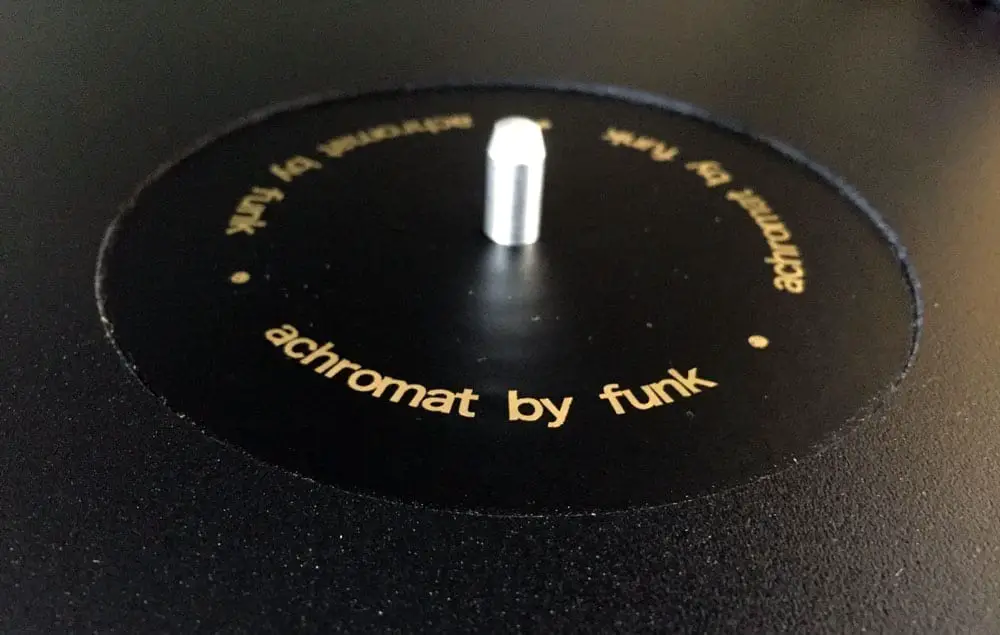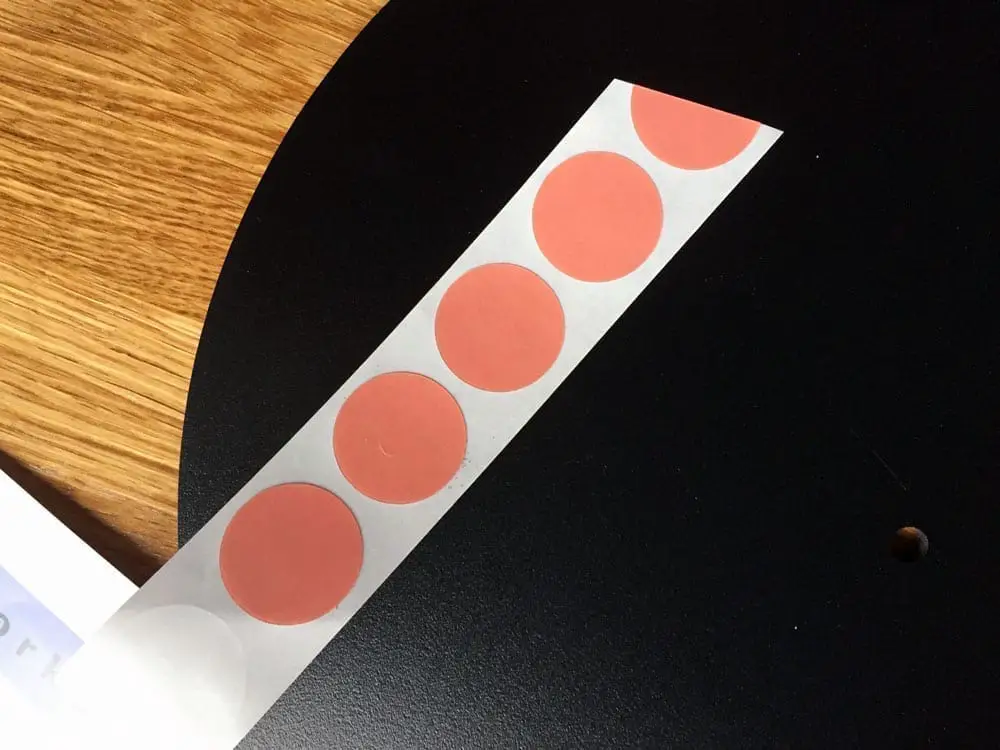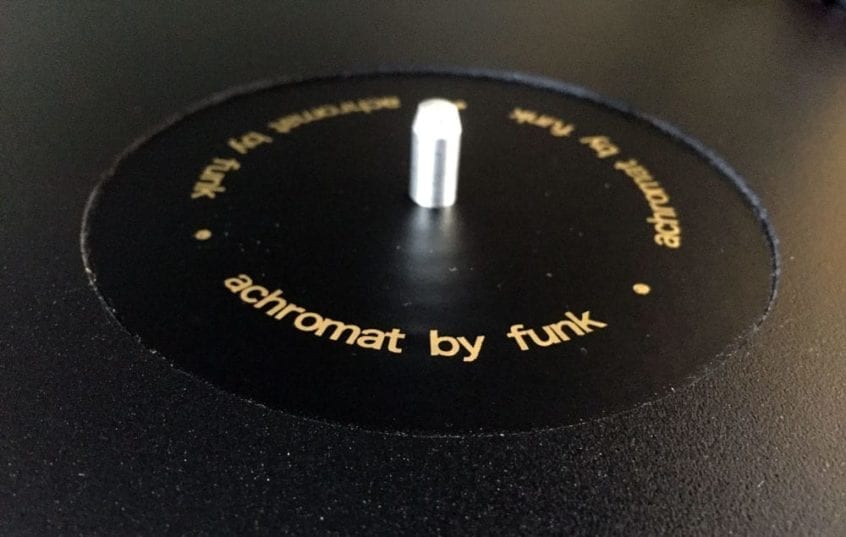Controlling turntable resonance is imperative if you want to achieve the best possible sound from your vinyl records. All turntables require damping to control external and mechanical resonance, and even modest setups can receive a significant performance improvement from just a little attention in this area.
Acrylic platters are revered across the hi-fi industry for helping to drastically reduce turntable resonance and deliver a tighter, more focused sound than metal or MDF platter options. The Achromat is a development born from the acrylic concept by the inventor of the acrylic platter himself, Arthur Khoubesserian. His company, The Funk Firm, deliver creative and innovative solutions to many common turntable resonance issues, while also producing some mighty fine turntables in their own right.
Traditional felt, leather, and cork slip mats go some way toward damping unwanted vibrations, but the Achromat claims to go further by effectively absorbing the vibrations transferred into the record during playback. Absorbing these record vibrations is important because, if left unchecked, this unwanted noise is later processed by the cartridge, resulting in less clarity.
How does Achromat absorb stylus vibration?
The Achromat claims to perfectly impedance match a vinyl record, which in simple terms means that the mat surface has similar if not the same characteristics as the record. When the material is very different (say felt, or even cork) the vibration energy released during playback cannot easily transfer from the record surface to the mat, and therefore, it cannot diffuse and may end up being processed by the cartridge. Achromat combines impedance matching with a complex internal construction of microscopic tunnels where vibration energy is rapidly diffused into tiny amounts of heat energy.

Does it work?
Yes, remarkably so. Even on a relatively humble setup, I noticed a significant improvement when swapping cork or felt for the Achromat. The bass is tighter, the mids and highs have greater separation, and overall, the result is more natural and spacious sounding. I could spend evening-after-evening rediscovering my record collection, each time enjoying the impressive level of new depth and detail. For the initial test, I span a copy of Counting Crows August and Everything After (a record I regard as having exceptionally good instrument space and separation). The Achromat helped to bring the subtle Fender Rhodes style organ out from the background, each chord clear and distinct.
For the best results, consider gently fixing the mat to your turntable platter using double-sided tape. This will prevent the mat from slipping and degrading the sound quality (a common issue when the material is similar to the record platter). My copy shipped with variable tack adhesive discs that leave no residue and allow you to remove the mat at a later date by gently lifting with a blunt knife.

A note on VTA (Vertical Tracking Angle)
The standard Achromat is 5mm thick. A 3mm version is available for turntables where the VTA is not adjustable. (Vertical Tracking Angle refers to the angle of the tonearm when viewed from the side). The thicker version will produce the best audible results, but be aware of raising the record too high to a point where VTA can start to affect the Stylus Raking Angle (SRA), which is the angle at which the stylus is raking the record grooves. In short, if this angle isn’t optimized, you may incur intermodulation distortion, but this is a topic for another day.
The Bottom Line
There’s real science and passion behind what The Funk Firm do, and it’s clear from the Achromat product that their commitment to sonic excellence continues to pay off with real results. Long after Arthur Khoubesserian first pioneered the acrylic platter back in 1979, his approach is now widely recognized and replicated by manufacturers across the industry. If that’s not a glowing endorsement of his engineering skill, I don’t know what else is. The Achromat is a continuation of this legacy, and it sounds awesome.




I use two old records double sided together – my ringy aluminium platter is now as dead as an acrylic platter – cost next to nothing !
What complete and utter bollocks.
So why can’t I just use an old LP as a mat?
So funny I nearly spewed!!!???????????? actually I’m still laughing. Thanks I needed that!
I had the same thought. No spewing involved. The edges and label of an LP are raised so that should minimize the danger of scratching of the grooves, and it’s essentially free. Worth a try to see what it sounds like.
[…] that this innovative new design is up there with the best available, including the Soundeck and the FunkFirm Achromat. Arguably, the HEX MAT is also the prettiest of the three. Hats off to Zsolt Fajt and his team for […]
[…] The Achromat is a further development on the acrylic platter concept by the inventor of the acrylic platter himself, Arthur Khoubesserian (Owner of The Funk Firm). The Achromat claims to perfectly impedance match a vinyl record, which in simple terms means that the mat surface has similar if not the same characteristics as the record. When the material is very different (say felt, or even cork) the vibration energy released during playback cannot easily transfer from the record surface to the mat, and therefore, it cannot defuse and may end up being processed by the cartridge. Achromat combines impedance matching with a complex internal construction of microscopic tunnels where vibration energy is rapidly diffused into tiny amounts of heat energy — seriously clever stuff. You can read our full review of this unique turntable mat, here. […]
Interesting article. I am searching for a replacement mat for my Technics SL-D3 which got warped and brittle while in storage. Do you know if the weight of these is proper and which thickness I would need? Also, I noticed you used the word “defuse” a couple of times. Did you perhaps mean to say “diffuse”?
The achromat is very light-weight. The 5mm thickness mat is ideal if you have the ability to adjust the VTA (I’m not sure you can on the SL-D3). In which case, the 3mm version might be better if it’s closer to the thickness of the original rubber mat?
And yes, I mean diffuse. Thanks for spotting that.
Hi:
I have two turntables: the first one I purchased, a Sony PSLX300USB, a true beginners table, and an Audio Technica 1200x.
I use the AT as my primary turntable, but I left the Sony hooked up via my receiver’s first input. I used the Sony’s built in phono preamp.
I have tried various upgrades with the Sony. I purchased a better stylus, balanced the table, made sure the legs were properly isolated, adjusted the speed, and recently replaced the rubber mat with a cork mat.
Except for the stylus upgrade (which cost $49 US) the cork mats made the most obvious sonic impact.
The separation, and sound stage both improved, while I could play vinyl at substantial volume without a noticeable problem with feedback. I was surprised at the difference the cork mat made. And the cost was a minimal $12 US.
After reading your article I plan to check into an acrylic mat for my AT turntable.
Interesting article.